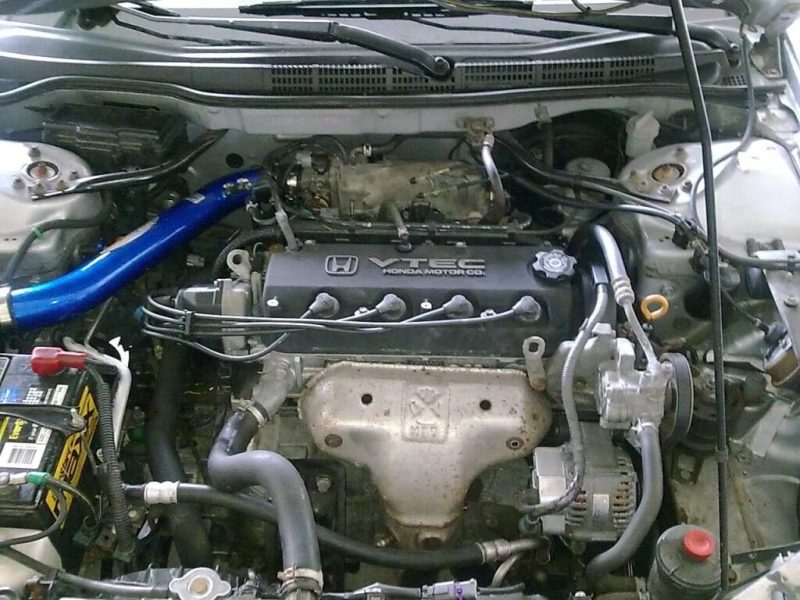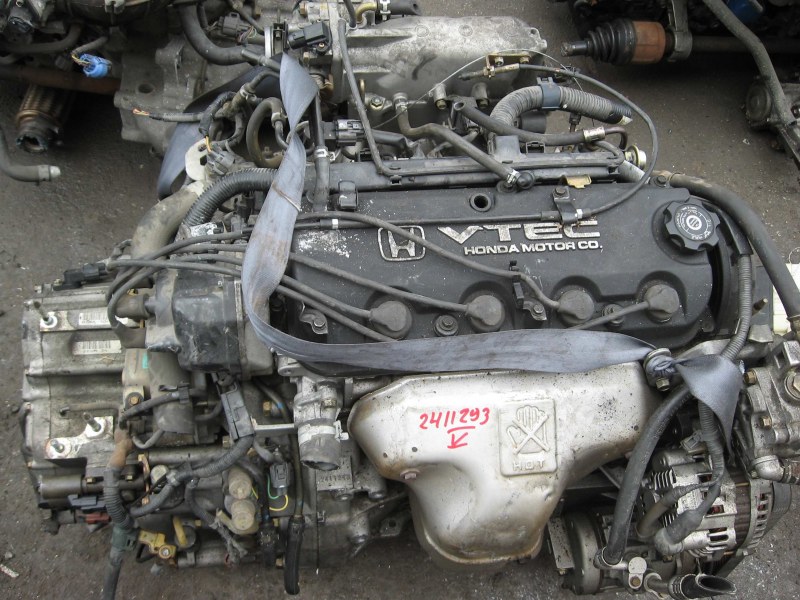Honda F23A engine with a capacity of 2.3 liters is a reliable and popular power unit, which was installed on Honda and Acura cars from the late 90s to the early 2000s. It was available both in modifications without VTEC system (F23A5) and with VTEC system (F23A1, F23A4 and F23A7). Both variants have in-line 4-cylinder aluminum cylinder blocks and 16-valve aluminum block head.
Honda F23A 2.3 liter engine specifications
Modification without VTEC (F23A5)
| Characteristics | Value |
|---|---|
| Exact volume | 2254 cm³ |
| Power system | Injector |
| Power | 135 hp |
| Torque | 205 Nm |
| Cylinder block | Aluminum, in-line 4-cylinder |
| Block head | Aluminum, 16 valves |
| Cylinder diameter | 86 mm |
| Piston stroke | 97 mm |
| Compression ratio | 8.8 |
| Features | SOHC |
| Hydrocompensators | No |
| Transmission timing | Belt |
| Fasoregulator | No |
| Turbocharger | No |
| Engine Oil | 4.3 liters 5W-30 |
| Ecological class | Euro 3 |
| Example service life | 350,000 km |
Modifications with VTEC (F23A1, F23A4 and F23A7)

| Characteristic | Value |
|---|---|
| Exact volume | 2254 cm³ |
| Power system | Injector |
| Power | 150 hp |
| Torque | 205 Nm |
| Cylinder block | Aluminum, in-line 4-cylinder |
| Block head | Aluminum, 16 valves |
| Cylinder diameter | 86 mm |
| Piston stroke | 97 mm |
| Compression ratio | 9.3 |
| Features | SOHC, VTEC |
| Hydrocompensators | No |
| Transmission timing | Belt |
| Fasor regulator | VTEC |
| Turbocharger | No |
| Engine Oil | 4.3 liters 5W-30 |
| Environmental class | Euro 3/4 |
| Example service life | 330,000 km |
Engine Application
The F23A engine was installed in the following models:
- Acura CL 1 (YA) – 1997-1999
- Honda Accord 6 (CG) – 1997-2002 years
- Honda Odyssey 1 (RA) – 1994-1999.
- Honda Odyssey 1 USA (RA) – 1994-1998.
- Honda Odyssey 2 (RA6) – 1999-2003
Honda F23A engine design and repair
The most voluminous engine of the F series was released in 1997 and was named F23. It was developed on the basis of an open 2.2-liter cylinder block, but the cylinder diameter was increased by 1 mm (to 86 mm), and a crankshaft with a piston stroke of 97 mm was installed in the block. The height of the cylinder block is unchanged at 219.5 mm and there are also two balancer shafts. The F23A engine uses short lightweight connecting rods with a length of 141 mm and lightweight pistons. The compression height of the pistons has been reduced to 30mm. All this made it possible to build a 2.3 liter motor on the old block.
The F23A uses a single-shaft SOHC cylinder head with 16 valves. VTEC system is used on this head. The diameter of the valves has not changed: intake 34 mm, exhaust 29 mm. To drive the camshafts, a timing belt is used, its replacement is required every 90 thousand kilometers. If it breaks, your motor will bend the valves.

Also every 40-50 thousand kilometers on F23A it is necessary to adjust the valves. Valve clearances on a cold engine: intake 0.23-0.27 mm, exhaust 0.27-0.33 mm.
The injector capacity on this engine is 240 cc.
This F23A was part of the F-motor range and had several related models: F18, F20 and F22. In addition to this series, a very close to them sporty H series (H22 and H23) was produced together with F-motors.
Honda F23A engine was produced until 2003, and after that instead of it began to install a 2.4-liter K24A.
Modifications of Honda F23 engine
- F23A1 is a basic motor with VTEC and compression ratio 9.3. Power is 152 hp at 5700 rpm, torque 205 Nm at 4900 rpm. The engine was used in Accord and Acura CL.
- F23A4 is an environmentally friendly version of the F23A1 for the Accord. The motor has a clamped intake, exhaust and a different brain installed. Its output is 150 hp at 5,700 rpm, 203 Nm of torque at 4,000 rpm.
- F23A5 is an engine without VTEC and with compression ratio lowered to 8.8. Power is 135 hp at 5500 rpm, torque is 206 Nm at 4500 rpm. It was used in Honda Accord.
- F23A7 – analog F23A1 for Honda Odyssey and Isuzu Oasis.
Honda F23A engine problems and disadvantages
- Elevated oil consumption: Many owners notice an increase in oil consumption (oil glut) after 100,000 kilometers of mileage. This may be due to wear of oil caps or piston rings.
- Oil and coolant leaks: The engine is prone to oil and coolant leaks, especially in the area of gaskets and oil seals, which require regular inspection and replacement of seals.
- Instable RPMs and Trolling: Contamination of the idle valve (COX) and the exhaust gas recirculation system (EGR) often leads to unstable engine operation and stalling.
- Wear of the timing belt: The timing belt should be replaced every 90,000 kilometers. If it breaks, there is a high probability of valve bending, which can lead to serious engine damage.
- No hydrocompensators: Since the engine has no hydrocompensators, valve adjustment should be performed every 40,000 km to maintain proper engine operation.
Engine tuning
Atmospheric
To increase the power to 200-210 hp at the flywheel, you need to put an F22A cylinder head and do all the things written at the end of the article here. Or do on pistons from K20A2 and stock connecting rods, this will increase the compression ratio to 12.3.
MOTOR RATING: 4
